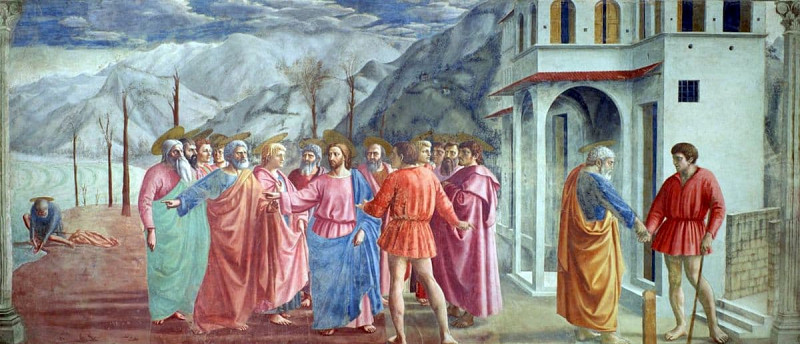Tribute money Tommaso Masaccio (1401-1428)
Tommaso Masaccio – Tribute money
Edit attribution
Download full size: 1200×515 px (0,1 Mb)
Painter: Tommaso Masaccio
This Fresco is considered the best. It is sometimes referred to as "The Giving." This episode is taken by Masaccio from the Gospels. Christ was traveling with his apostles through various cities. One day they come to Caperanum. Before they could enter, they had to pay only one statir. But they had no money at all. Christ gave an order to Peter. He was to catch a fish and extract the coveted statier from it. The viewer is faced with a series of connected episodes.
Description of Masaccio’s fresco "The Miracle with the Statyr"
This Fresco is considered the best. It is sometimes referred to as "The Giving."
This episode is taken by Masaccio from the Gospels. Christ was traveling with his apostles through various cities. One day they come to Caperanum. Before they could enter, they had to pay only one statir. But they had no money at all. Christ gave an order to Peter. He was to catch a fish and extract the coveted statier from it.
The viewer is faced with a series of connected episodes. We see Christ in the center. He is surrounded by the apostles. He points out to Peter what needs to be done. On the left side we see Peter catching a fish. On the right side Peter is already giving the statyr to the man collecting taxes.
Many scholars have wondered why Masaccio decided to include this story in his cycle of frescoes. This episode has been interpreted in different ways. It seems that the artist specifically emphasizes the legality of such taxes. The story was included in the cycle of frescoes because just at that time there was a debate about tax reform. The Cadastre, which established taxation in a fairer form, was adopted in 1427.
All the figures are lined up. A group of apostles forms a semicircle. According to researchers, it clearly comes from antiquity. In ancient times Socrates and his disciples were depicted in such a way. Then it became the way Jesus was depicted in the art of early Christianity. Later, the circle became a symbol of completeness and perfection.
Each character is different. The viewer sees a vivid embodiment of the characters. All the figures are dressed in tunics, as in antiquity. One Peter took off his tunic for fear of getting it dirty while catching fish. All the poses of the characters resemble those of the statues.
It is no coincidence that Masaccio used a rarely seen subject. The composition is executed in such a way that the action seems continuous. The juicy colors are striking.
This is truly Masaccio’s finest creation.
Кому понравилось
Пожалуйста, подождите
На эту операцию может потребоваться несколько секунд.
Информация появится в новом окне,
если открытие новых окон не запрещено в настройках вашего браузера.
You need to login
Для работы с коллекциями – пожалуйста, войдите в аккаунт (open in new window).


















You cannot comment Why?
This fresco depicts the biblical scene The Tribute Money, featuring Jesus and his disciples.
What I see:
The painting is divided into three main parts:
Subtexts and Interpretations: